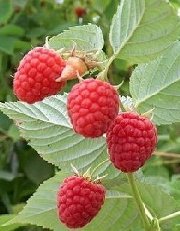Raspberry has been postulated to originate from the Ide mountains of Turkey. The Raspberry or more correctly Red Raspberry (Rubus idaeus) grows wild in some parts of Great Britain and is a native of many parts of Europe. The stems are erect and shrubby, biennial, with creeping perennial roots. Depending on the variety, it can flower and produce fruit from May to September.

The red composite fruit is not strictly speaking a berry, but is an aggregate fruit comprising numerous drupelets around a central core. Red raspberry is a source of a dietary supplement sold in many health food stores called ellagic acid. Ellagic acid is found naturally in raspberries and is thought to be an important component of the antioxidant activity of raspberries. Antioxidants in berry extracts can effectively inhibit the oxidation of low density lipoproteins in the blood which can prevent plaque formation and reduce incidence of heart attacks.
| T |
Raspberries have been bred at the Institute for over 40 years and the breeding programme has resulted in many successful cultivars. The Institute's raspberries are all named after Scottish valleys or glens, so you will find Glen Ample (the number one variety in the UK) and Glen Lyon (the number one variety in Spain).
Further pages in this section provide a brief introduction to various aspects of raspberries and their research at the Institute. By following these links, you can view details of the Institute's raspberry varieties (including the new variety Glen Doll pictured opposite) and more details of the Institute's raspberry breeding programme. You can also see extensive details of our health and nutrition work at FruitNutrition.
